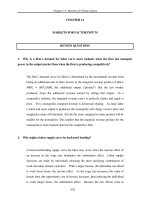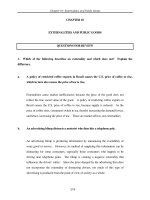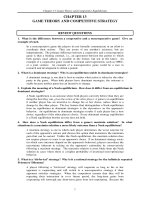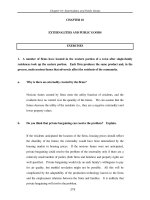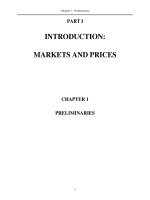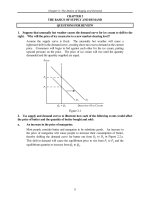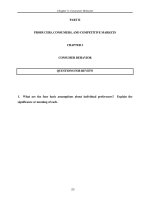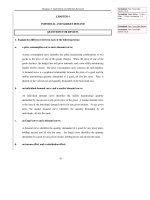Câu hỏi đánh giá môn Kinh tế vĩ mô bằng tiếng Anh- Chương 18
Bạn đang xem bản rút gọn của tài liệu. Xem và tải ngay bản đầy đủ của tài liệu tại đây (54.19 KB, 7 trang )
Chapter 18: Externalities and Public Goods
278
CHAPTER 18
EXTERNALITIES AND PUBLIC GOODS
QUESTIONS FOR REVIEW
1. Which of the following describes an externality and which does not? Explain the
difference.
a. A policy of restricted coffee exports in Brazil causes the U.S. price of coffee to rise,
which in turn also causes the price of tea to rise.
Externalities cause market inefficiencies because the price of the good does not
reflect the true social value of the good. A policy of restricting coffee exports in
Brazil causes the U.S. price of coffee to rise, because supply is reduced. As the
price of coffee rises, consumers switch to tea, thereby increasing the demand for tea,
and hence, increasing the price of tea. These are market effects, not externalities.
b. An advertising blimp distracts a motorist who then hits a telephone pole.
An advertising blimp is producing information by announcing the availability of
some good or service. However, its method of supplying this information can be
distracting for some consumers, especially those consumers who happen to be
driving near telephone poles. The blimp is creating a negative externality that
influences the drivers’ safety. Since the price charged by the advertising firm does
not incorporate the externality of distracting drivers, too much of this type of
advertising is produced from the point of view of society as a whole.
Chapter 18: Externalities and Public Goods
279
2. Compare and contrast the following three mechanisms for treating pollution externalities
when the costs and benefits of abatement are uncertain: (a) an emissions fee, (b) an emissions
standard, and (c) a system of transferable emissions permits.
Since pollution creates an external cost that is not reflected in the marginal cost of
production, its emission creates an externality. Three policy tools can be used to
reduce pollution: an emissions fee, an emissions standard, and a system of
transferable permits. The choice between a fee and a standard will depend on the
marginal cost and marginal benefit of reducing pollution. If small changes in
abatement yield large benefits while adding little to cost, the cost of not reducing
emissions is high. Thus, standards should be used. However, if small changes in
abatement yield little benefit while adding greatly to cost, the cost of reducing
emissions is high. Thus, fees should be used.
A system of transferable emissions permits combines the features of fees and
standards to reduce pollution. Under this system, a standard is set and fees are
used to transfer permits to the firm that values them the most (i.e., a firm with high
abatement costs). However, the total number of permits can be incorrectly chosen.
Too few permits will create excess demand, increasing price and inefficiently
diverting resources to owners of the permits. Typically, pollution control agencies
implement one of three mechanisms, measure the results, reassess the success of
their choice, then reset new levels of fees or standards or select a new policy tool.
3. When do externalities require government intervention? When is such intervention
unlikely to be necessary?
Economic efficiency can be achieved without government intervention when the
externality affects a small number of people and when property rights are well
specified. When the number of parties is small, the cost of negotiating an agreement
among the parties is small. Further, the amount of required information (i.e., the
costs of and benefits to each party) is small. When property rights are not well
Chapter 18: Externalities and Public Goods
280
specified, uncertainty regarding costs and benefits increases and efficient choices
might not be made. The costs of coming to an agreement, including the cost of
delaying such an agreement, could be greater than the cost of government
intervention, including the expected cost of choosing the wrong policy instrument.
4. Consider a market in which a firm has monopoly power. Suppose in addition that the
firm produces under the presence of (i) a positive or (ii) a negative externality. Does the
externality necessarily lead to a greater misallocation of resources?
In the presence of a negative externality the market will produce too much output,
as compared to the socially optimal solution. The monopolist will however
produce too little output. It is possible therefore that the monopolist by himself
will produce closer to the socially optimal solution than the competitive firms
would. For the case of the positive externality the competitive firms will
produce too little output, the monopolist will produce even less, and the
monopolist is therefore leading to a greater misallocation of resources.
5. Externalities arise solely because individuals are unaware of the consequences of their
actions. Agree or disagree? Explain.
This is not a true statement. It is not that people are unaware but that they are
not forced to consider and account for all of the consequences of their actions. If
a firm dumps waste into a river that affects a swimming area downstream it is
generating an externality given it is not forced to consider the cost it is imposing
on users of the swimming area. This is true whether the firm is aware of these
costs or not.
6. To encourage an industry to produce at the socially optimal level the government
should impose a unit tax on output that is equal to the marginal cost of production. True
or false? Explain.
Chapter 18: Externalities and Public Goods
281
This statement is false. While a tax can encourage firms to produce at the
socially optimal level, the tax should be set equal to the marginal external cost
and not the marginal private cost. Firms will maximize profit by producing at
the point where price is equal to marginal cost. When there are external costs
involved the marginal cost of the firm is too low from society’s point of view, and
as a result too much output is produced. By setting a tax equal to the additional
cost not being realized by the firm (the marginal external cost) the firm will be
encouraged to consider all costs and will reduce output because the tax will
increase the overall marginal cost.
7. George and Stan live next door to each other. George likes to plant flowers in his
garden, but every time he does, Stan’s dog comes over and digs them up. Since it is Stan’s
dog that is causing the damage, if economic efficiency is to be achieved, it is necessary that
Stan pay to put up a fence around his yard to keep the dog in. Agree or disagree?
Explain.
If there are leash laws then this would be true. Stan would either need to keep
his dog on a leash or put up a fence. In general, it is possible for the two parties
to bargain and come up with a solution that will benefit both of them. They
could for example split the cost of the fence. Economic efficiency does not
require that Stan pay for the fence. It merely requires that Stan and George
negotiate over how best to address the problem and come up with a solution that
will work for both of them.
8. An emissions fee is paid to the government, whereas an injurer who is sued and held
liable pays damages directly to the party harmed by an externality. What differences in the
behavior of victims might you expect to arise under these two arrangements?
When victims can receive the damages directly, they are more likely to file a claim,
initiate a suit, and try to overstate their damages. When victims are not able to
receive the damages directly, they are less likely to report violations and are less
Chapter 18: Externalities and Public Goods
282
likely to overstate their damages. In theory, emissions fees paid to the government
require the polluting firm to pay compensation for any damage inflicted and hence
to move towards the socially optimal level of production. An individual who is
injured by a firm’s polluting behavior is again less likely to file a complaint if they
do not feel they can directly receive the compensation.
9. Why does free access to a common property resource generate an inefficient outcome?
Free access to a resource means that the marginal cost to the user is less than the
social cost because each user has no incentive to consider how his use of the
resource will affect the use of the resource by other users. The use of a common
property resource by a person or firm excludes others from using it. For example,
the use of water by one consumer restricts its use by another. Since private
marginal cost is below social marginal cost, too much of the resource is consumed
by the individual user, creating an inefficient outcome. Each individual using the
common property resource considers only his own actions and does not consider
how all of the users collectively are impacting the resource.
10. Public goods are both nonrival and nonexclusive. Explain each of these terms and
show clearly how they differ from each other.
A good is nonrival if, for any level of production, the marginal cost of providing the
good to an additional consumer is zero (although the production cost of an
additional unit could be greater than zero). A good is nonexclusive if it is
impossible or very expensive to exclude individuals from consuming it. Public
goods are nonrival and nonexclusive. Commodities can be (1) exclusive and rival,
(2) exclusive and nonrival, (3) nonexclusive and rival, or (4) nonexclusive and
nonrival. Most of the commodities discussed in the text to this point have been of
the first type. In this chapter, we focus on commodities of the last type.
